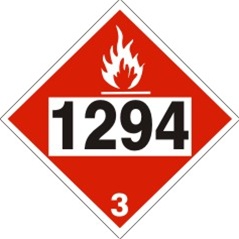

FLAMMABLE LIQUID PLACARD IDMG ISO
(i) are known to be toxic or corrosive to humans according to CGA P-20, ISO Standard 10298 or other documentary evidence published in technical journals or government publications, or (c) Class 2.3, Toxic Gases, which consists of gases that (b) Class 2.2, Non-flammable and Non-toxic Gases, which consists of gases that are transported at an absolute pressure greater than or equal to 280 kPa at 20☌, or as refrigerated liquids, and that are not included in Class 2.1, Flammable Gases, or Class 2.3, Toxic Gases and (ii) have a flammability range with air of at least 12 percentage points determined in accordance with tests or calculations in ISO 10156 (i) are ignitable when in a mixture of 13% or less by volume with air, or (a) Class 2.1, Flammable Gases, which consists of gases that, at 20☌ and an absolute pressure of 101.3 kPa, (c) a mixture of one or more gases with one or more vapours of substances included in other classes Ģ.14 Class 2, Gases, has three divisions: (a) a gas included in one of the three divisions set out in section 2.14 Class 2, Gases GeneralĢ.13 A substance is included in Class 2, Gases, if it is Packing GroupsĢ.12 Explosives are included in Packing Group II. (f) Class 1.6, extremely insensitive articles with no mass explosion hazard.Ģ.11 Explosives are divided into 13 compatibility groups as described in Appendix 2, Description of Compatibility Groups, Class 1, Explosives, to this Part. (e) Class 1.5, very insensitive substances with a mass explosion hazard and (d) Class 1.4, no significant hazard beyond the package in the event of ignition or initiation during transport (c) Class 1.3, fire hazard and either a minor blast hazard or a minor projection hazard or both but not a mass explosion hazard (b) Class 1.2, projection hazard but not a mass explosion hazard (b) designed to produce an explosive or pyrotechnic effect by heat, light, sound, gas or smoke or a combination of those means as a result of non-detonative, self-sustaining exothermic chemical reactions.Ģ.10 Class 1, Explosives, has six divisions: (a) capable, by chemical reaction, of producing gas at a temperature, pressure and speed that would damage the surroundings or Source: 49 CFR §172.PART 2 Classification (continued) Class 1, Explosives GeneralĢ.9 Substances are included in Class 1, Explosives, if they are Source: 49 CFR §172.528, 172.530, 172.532, 172.540 Label In addition to complying with 49 CFR §172.407, the background color on the FLAMMABLE LIQUID label must be red. The word “GASOLINE” must be shown in white.
FLAMMABLE LIQUID PLACARD IDMG PORTABLE
The word “GASOLINE” may be used in place of the word “FLAMMABLE” on a placard that is displayed on a cargo tank or a portable tank being used to transport gasoline by highway. The symbol, text, class number and inner border must be white. In addition to complying with 49 CFR §172.519, the background color on the FLAMMABLE placard must be red. FUEL OIL may be used in place of COMBUSTIBLE on a cargo or portable tank transporting fuel oil not classed as a flammable liquid by highway. See §172.504(f)(2) for use of FLAMMABLE placard in place of COMBUSTIBLE. Placard combustible liquid transported in bulk. GASOLINE may be used in place of FLAMMABLE placard displayed on a cargo tank or portable tank transporting gasoline by highway.

PlacardsFor FLAMMABLE, placard 454 kg (1,001 lbs) or more.


 0 kommentar(er)
0 kommentar(er)
